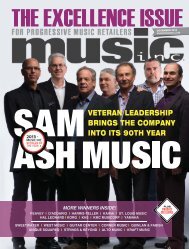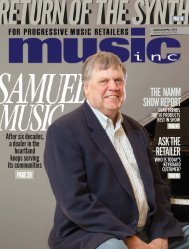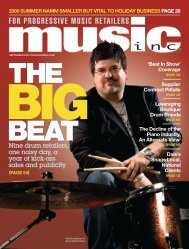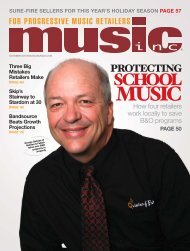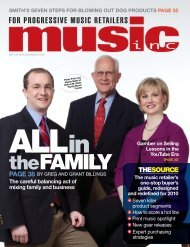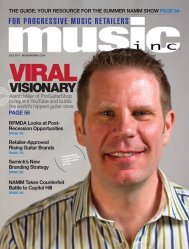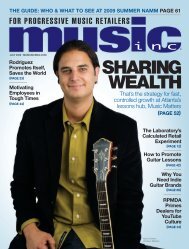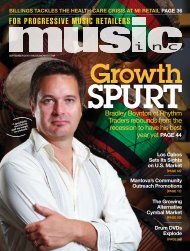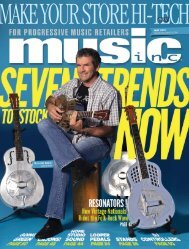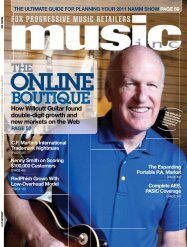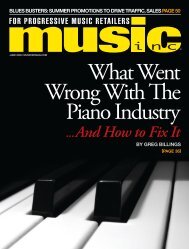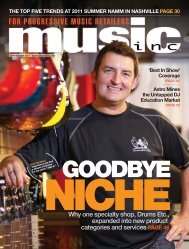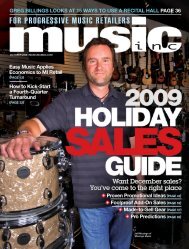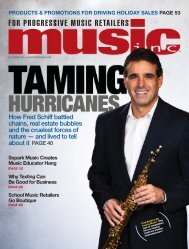Create successful ePaper yourself
Turn your PDF publications into a flip-book with our unique Google optimized e-Paper software.
InsideiDeaS<br />
> The Customer Whisperer Page 34 > The Retail Doctor Page 36 > The Lesson Room Page 38 > Lessons Learned Page 40<br />
iNDEPENDENT RETAil i BY TED EScHliMAN<br />
SeLLiNg SoLuTioNS<br />
It’s easy to get bogged down<br />
in the “business” of business.<br />
Stocking shelves, straightening<br />
displays, monitoring gross margin<br />
levels — we ponder buying<br />
decisions and selling strategies<br />
based on the mundane stuff: what<br />
we hope our customers will be<br />
doing with our products.<br />
If your business is wired simply<br />
to acquire and move “stuff,”<br />
let me suggest an additional dynamic<br />
that could energize all<br />
levels of operation, purchasing,<br />
merchandising and sales training<br />
— the notion of solutions. At the<br />
recent NAMM show, Bob Phibbs,<br />
a.k.a. The Retail Doctor, introduced<br />
his modification of classic<br />
FAB (feature-advantage-benefit)<br />
selling: “It has ... so you ...” In a<br />
nutshell, this puts the focus on<br />
application and context before the<br />
goods themselves.<br />
YoU’RE THE THERAPiST<br />
With old-school retail, we<br />
filled our stores with goods<br />
we thought we could sell, and we<br />
waited for customers to come in<br />
and buy them. If all worked out,<br />
we talked customers into needing<br />
the goods. Now, with turbocharged<br />
competitive new-school<br />
retail — and proper attention to<br />
turns and gross margin return on<br />
‘The best mindset<br />
is to think<br />
of our goods as<br />
prescriptions<br />
to problems.’<br />
investment — we can ill afford to<br />
warehouse deeply anything that<br />
won’t meet customer needs and<br />
yield near-immediate profits. Stale<br />
inventory stunts cash flow and<br />
kills retailers. It’s more important<br />
than ever to track customer<br />
needs and stock inventory around<br />
those wants and desires. To do<br />
so, the best mindset is to think<br />
of our goods as prescriptions to<br />
problems. We become shelves and<br />
hooks filled with solutions. Just<br />
as important, our staff becomes<br />
the face, counselor and therapist<br />
equipped to help the consumer<br />
enjoy and grow in the craft.<br />
At NAMM, Roland founder<br />
Ikutaro Kakehashi mentioned this<br />
notion, likening the music store<br />
to a family doctor. We may not<br />
always have the remedies for the<br />
entire music community packed<br />
within our store walls, but we<br />
can frame our businesses as the<br />
go-to place. It starts when a musician<br />
needs a resource or tool<br />
to advance his or her art. When<br />
we go to trade shows looking for<br />
solutions, we equip ourselves for<br />
greater relevance in our markets.<br />
For example, consider the<br />
Apple iPad’s growing popularity.<br />
At NAMM, we looked at a lot of<br />
new implements that would bridge<br />
iPad use with the musician. It’s<br />
not just a gadget, and seeking out<br />
iPad clips, mounts, pouches and<br />
devices became a show priority.<br />
The ravenous market hunger for<br />
ukuleles also had us on the hunt<br />
for method books, class materials,<br />
and an array of new body<br />
styles and designs to bring this<br />
activity home. And an increasing<br />
interest in niche folk instruments<br />
had us checking out new guitar,<br />
mandolin and banjo lines that<br />
local competition wasn’t stocking.<br />
iN-SToRE coNSiDERATioNS<br />
Our stores should be clean and<br />
logically arranged. Essential<br />
accessories and instruments can’t<br />
be displayed on opposite sides<br />
of the showroom. Again, associate<br />
activity (playing guitar) with<br />
need (instrument maintenance,<br />
chord book, strap), and display<br />
with minimal physical barriers.<br />
We also need staff trained and<br />
tuned to these evolving requirements.<br />
Our employees need to be<br />
able to speak intelligently about<br />
the goods or at least know how<br />
to access outside resources for<br />
more information.<br />
Plus, solution selling is about<br />
“delivery.” A storefront’s not<br />
enough. Today’s retail is about<br />
having displays marked effectively<br />
for a consumer who would rather<br />
read signage than be sold by a<br />
salesperson. Outside the store,<br />
we need a cyber presence that, at<br />
minimum, advertises how we can<br />
get goods to consumers in-store<br />
with sensitivity to a busy culture.<br />
A good store is a prescription<br />
— medicine for the soul. MI<br />
Ted Eschliman is a 30-year veteran of<br />
music retail and co-owner of Dietze <strong>Music</strong><br />
in Southeast Nebraska. Mel Bay published<br />
his book, Getting Into Jazz Mandolin.<br />
MAY 2011 I MUSIC INC. I 33



